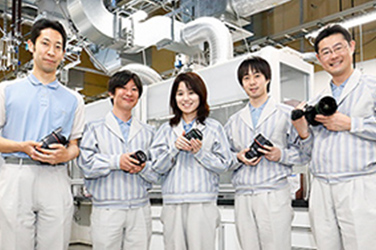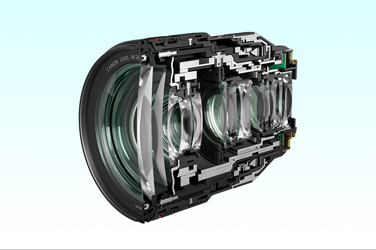

Realizing a 100-500mm zoom that delivers high image quality in a smaller, lighter body
RF Super-telephoto Zoom Lens
The impressive sight of airplanes at takeoff and landing, fleeting expressions on the faces of athletes giving their all at sports events…There are many scenes around us that are best captured with a telephoto lens. Canon has successfully created a super-telephoto zoom lens that not only boasts a greater zoom range than before, but does so in a more compact and lightweight body, increasing the range of photographic possibilities.
April 5, 2021Featured Technology
Expanding creative possibilities of photography with a 100-500mm zoom range
Whether it is a decisive moment in sports or the split second where a wild bird dives into the water for prey, the reach of a telephoto lens is crucial for framing the image for maximum impact. Canon’s 100-400mm zoom lens has become a go-to lens for many photographers, professional or otherwise. Due to their wide focal length coverage, these lenses are useful for capturing subjects around us that are much further away, such as trains and airplanes. A further increase of the zoom range would certainly lead to more possibilities in photographic expression. However, developing such a lens inevitably results in an increase in size and weight, as well as a deterioration in image quality—issues that could not be resolved at that time.
And yet, in 2020, Canon managed to commercialize the RF100-500mm F4.5-7.1 L IS USM, a telephoto lens for the EOS R series of digital cameras that covered a never-before achieved focal length range, and bring it to market. The company had overcome the difficulties of increasing the zoom range and making the lens lighter while maintaining image quality and AF speed. How was this possible? The secret was in the development of new key components, as well as the harnessing of many technologies and experience in lens design that Canon has accumulated over the years.
Harnessing the high image quality properties of the EOS R system to improve telephoto shooting performance
Canon has a super telephoto zoom lens—the EF 100-400mm f/4.5-5.6 L IS II USM—that provides wide zoom coverage and high image quality, and has enjoyed popularity for many years. What the users of this lens wanted the most was a longer telephoto zoom range. Therefore, when Canon decided to create a super-telephoto zoom lens for the EOS R mirrorless camera system, the developers brainstormed about how they could harness the large mount diameter and short back focus distance characteristic of the EOS R system.
There was the option to develop a lens that had the same specifications as the EF 100-400mm f/4.5-5.6L IS II USM but with a more compact and lightweight body. However, the developers ultimately chose to increase the telephoto focal length by 100mm to create a 100-500mm lens. This decision was spurred by the desire to allow more users to experience the world afforded by the 500mm super telephoto focal length range.
Simply expanding the focal length range alone would have “side effects” that include a larger lens size, slower AF speed, reduction in the amount of light that could enter the lens and deteriorated image quality. Having made it their mission to at least maintain the same image quality, AF speed and maneuverability, the Canon engineers had to revamp the entire lens design to resolve these issues one by one.
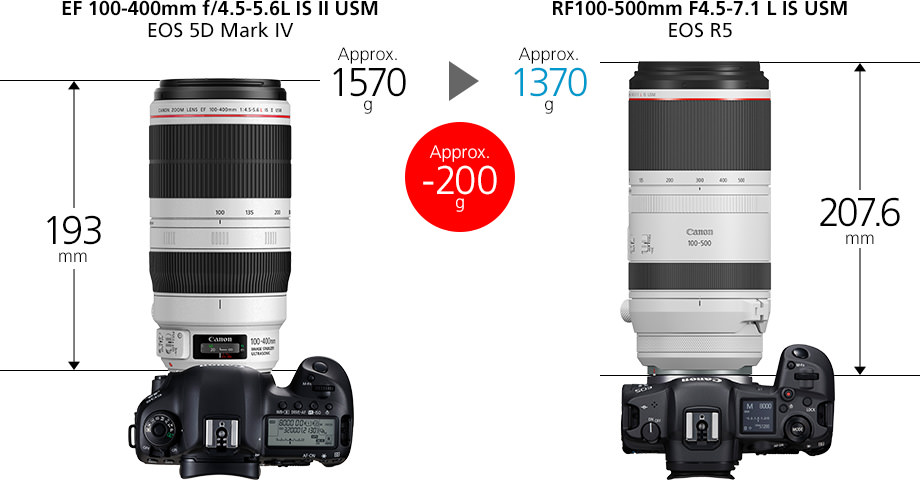
Canon managed to make the RF100-500mm F4.5-7.1 L IS USM (right) around 200g lighter than its EF-mount counterpart, the EF100-400mm f/4.5-5.6 L IS II USM (left) despite a 14.6mm increase in length.
Achieving a faster, smoother AF drive
Of all the Canon technologies incorporated into the RF100-500mm F4.5-7.1 L IS USM, the most unique is the electronic floating focus system, which employs dual Nano Ultrasonic Motors (USMs). The electronic floating focus system moves the lens element groups inside the lens in response to the shooting distance between the camera and the subject. The RF100-500mm F4.5-7.1 L IS USM has two groups of focusing lenses in order to correct aberrations over the wide zoom range, and the motor used to drive these two groups is a redesigned version of the tiny and thin Nano USM. The ring USM, which had been used in similar lenses, drives in a circular motion, which needs to be converted to linear motion to drive focus. In contrast, the Nano USM is a linear drive motor, and requires no such conversion. Adopting the latter was the natural solution, and its efficiency realizes the rapid AF drive on the lens.
The increase in zoom range on the RF100-500mm F4.5-7.1 L IS USM also meant an increase in the distance by which the lens elements have to be moved (stroke length) to length to approximately 1.5 times that on the RF70-200mm F2.8 L IS USM, which is also a telephoto zoom lens. In response, for the first time ever, a bearing mechanism was incorporated in the parts that connected the motor with the guide bars that supported the focusing lens groups. This greatly reduces friction when the lens groups are moved, allowing rapid, precise control over the large lens groups, thus resulting in seamless AF drive that is especially effective when shooting video.
The core technologies for controlling these two large focusing lens groups independently lies in something that is also crucial in television and smartphone screens: the control technology in flat panel display (FPD) lithography equipment. On FPD lithographic equipment, of which Canon is a leading manufacturer, two large plates must be moved quickly while simultaneously retaining speedy, submicron-level1 precision control of their position in relation to each other. The expertise behind this technology was used in the algorithm for controlling the focus mechanism on the RF100-500mm F4.5-7.1 L IS USM lens. This was possible because the lens development team happened to include an engineer who had assisted in the development of the FPD lithographic equipment, which was in turn possible because of Canon’s comprehensive strengths in optics.
- 1 1/10,000th of a millimeter
Ring USM

A USM(Ultrasonic Motor)is a motor that drives by creating linear waves from ultrasonic vibrations. Canon was the first in the world to successfully adapt these motors for practical applications. The ring USM is attached to a barrel-shaped cam mechanism, and converts rotational motion into linear motion. This enables the focus unit to be driven at high speed and stopped with high precision, resulting in fast AF.
Nano USM

The Nano USM uses a thin, chip-shaped oscillator to move back and forth via ultrasonic vibrations. As it already operates using linear motion, it can drive the focusing lenses directly, without the need for conversion. Offering better control than ring USM, it also allows smoother focus tracking when shooting video.

More UD lenses than any other Canon lens in history2, All for the thorough correction of chromatic aberration.
The traditional design of lenses for DSLR cameras did not allow lens elements to be placed near the image plane. To get around that and ensure edge-to-edge high image quality, it was necessary to place more lens elements towards the front of the lens. However, the large mount diameter and short back focus distance of the EOS R system allows lens elements to be placed close to the image plane, providing greater freedom in lens design, which also means that lens aberrations can be corrected more effectively. This makes possible a reduction in the number of large lens elements placed towards the front of the lens. In addition to this advancement, the development of the new Nano USM design realized a new floating and focusing mechanism that could be controlled independently.
Canon’s simulation technology, the product of many years of research, development and experience, was essential for improving the lens’ image quality. Simply having a computer and software is not enough—it is necessary to know the parameters of material properties to input, and that in itself requires expert knowledge. Changing even just one material affects the simulation results. Canon spared no effort in incorporating the know-how it had accumulated and polished via the many lenses that it had developed into the development of the RF100-500mm F4.5-7.1 L IS USM. Having such simulation technology enables Canon to optimize the placements of ASC (Air Sphere Coating) lens elements, which prevents ghosting and flaring, and the Super UD and UD lens elements that prevented chromatic aberration prone to occurring at telephoto focal length. In addition, it also lets Canon perform elaborate drop simulations to test the durability of the lenses.
- 2 As of December 2020.
EF 100-400mm f/4.5-5.6L IS II USM lens configuration
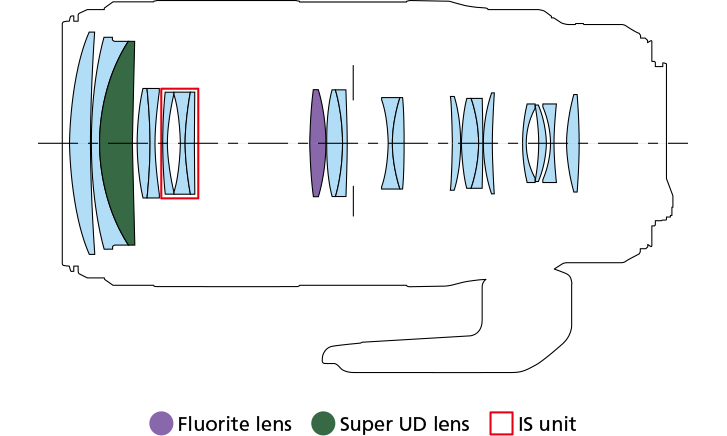
Telephoto lenses are prone to chromatic aberrations in the form of color bleeding on the outlines of subjects. The EF100-400mm F4.5-5.6 L IS II USM uses 1 fluorite lens and 1 Super UD lens, both of which have excellent chromatic aberration correction properties, to counteract such problems.
RF100-500mm F4.5-7.1 L IS USM lens configuration
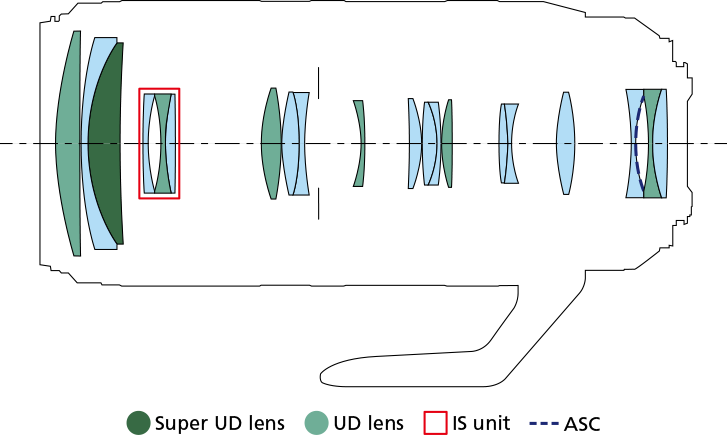
On an RF mount lens, a large lens element can be placed close to the image plane, enabling more effective correction of lens aberrations. The RF100-500mm F4.5-7.1 L IS USM contains 6 UD lenses and 1 Super UD lens, all of which have excellent chromatic aberration correction properties. This is more UD lenses than any other Canon lens in history3.
- 3 As of December 2020.
A complete redesigning for a lighter body
Keen on ensuring that users enjoyed shooting with the 100-500mm, Canon went to great lengths to make the lens lighter. Using the Nano USM instead of the ring USM reduced the number of necessary parts in the lens, reducing the weight. In addition, the lens engineers also painstakingly reexamined all the materials and parts used in the lens—including, for example, the adoption of an electronic manual focusing ring. The fundamental redesign that was originally aimed at making all parts of the lens as light as possible resulted in a significantly reduced weight of approximately 1370g (excluding tripod mount)—around 200g lighter than the existing EF 100-400mm f/4.5-5.6 L IS II USM (approximately 1570g, excluding tripod mount) despite the greater zoom range. At first glance, it might seem that the weight reduction was achieved due to the narrower maximum aperture at the telephoto end, but the maximum apertures of the 100-400mm range are the same as the 100-400mm lens. This demonstrates that the lens does indeed realize both lighter weight and high image quality.
Further expanding creative possibilities in telephoto photography
The RF100-500mm F4.5-7.1 L IS USM is Canon’s first 100-500mm focal length lens to achieve both a reduction in weight, while at the same time maintaining the excellent image quality that Canon is renowned for. Photographers can now shoot more creatively and comfortably than ever before, thus contributing to more possibilities in photography. Going forward, Canon will continue to improve on RF lens technology and increase the expressive possibilities available to photographers.


